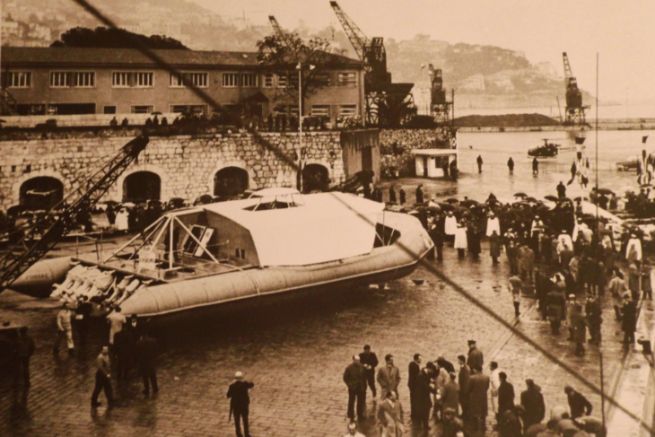
Why do we say Zodiac when talking about a rigid inflatable boat?
If you ask anyone to list the different types of boats they know, chances are that among the answers such as "Sailboat," "Rowboat," "Raft," "Catamaran," an intruder might slip in: the Zodiac.
Because indeed, unlike the other examples above, the Zodiac is not a common noun, but a trademark, which does not prevent it from appearing in the dictionary!
But where does this curiosity come from? Why do we use the term "Zodiac" to refer to an inflatable boat?
This is what is called in French an antonomasia, that is, a word or expression that is a proper noun coming to replace a common noun in usage. This is notably the case with other illustrious brands such as "Typex," "Blanco," "Post-It," "Frigidaire," "Kleenex," "Jacuzzi," "Scotch," and many others!
While the generic term "semi-rigid boat" is the common noun used in French by most brands, in everyday language, it is indeed the term Zodiac that remains popular!
Thus, in France, the expression "Zodiac Boat" is 6 times more searched on Google than "semi-rigid boat," and remains 50% more popular than "inflatable boat"!
How did the brand acquire this notoriety and make its way into our vocabulary? Orca Retail has the answer!
Brief history of inflatable boats
First of all, let's note that humans have long known that inflated volumes of air can help them navigate, with some sources dating their use back to antiquity, with at the time, animal skin boats!
But it wasn't until the mid-19th century that we find the first traces of inflatable boats, ancestors of the current Zodiacs.
It was the invention of the vulcanization process and the use of rubber by Charles Goodyear in 1839 (and the invention of tires) that allowed the creation of the first inflatable boats, since in the same year, the Duke of Wellington was the very first to try the principle.
The 1840s then saw the development of new models, with the notable example of the Englishman Thomas Hancock in 1840. Very quickly, the technique was used in many expeditions, including one to the Arctic in 1844. Yet, at this time, there was still no trace of Zodiac...
The brand and the inventors who changed everything
We can trace the origin of the Zodiac brand to the year 1896, when the company "Mallet, Mélandri et de Pitray" was founded in France. Maurice Mallet, a famous aeronaut of the time, was then involved in the development of the production of the first airships.
It was only in 1909 that the group changed its name to the iconic "Zodiac." However, the story doesn't end there.
It is to Pierre Debroutelle, a former airship pilot and engineer employed by the brand, that we owe the "modern" versions of the Zodiac inflatable boats, with a first prototype developed in 1934. .
The same year, a competitor named Paul Brot marketed his own semi-rigid boats under the brand PB before joining Zodiac with his patents.
These promising early trials were quickly validated when in 1937, the French National Navy ordered from the brand a boat capable of carrying torpedoes and bombs: this was the birth of Zodiac and the beginning of its industrial-scale production.
This model took on its well-known U shape and was equipped with two lateral air chambers joined by a wooden dashboard. The patent for this model was not filed until August 10, 1943, in the midst of the world conflict.
Semi-rigid boats marked the Second World War, allowing many aviators or sailors to save their lives once their plane or ship was shot down.
The Post-War
After the war, the success of Zodiac did not stop, on the contrary, since in 1950, ministerial decrees made it mandatory to have inflatable rafts on board commercial ships and all fishing boats over 25 tons.
Then, in 1952, another great name in navigation put the spotlight on the brand in the person of Dr. Alain Bombard (who thus gave his name to the competing brand of Zodiac, now well known). He then embarked on a transatlantic crossing from Tangier to Barbados aboard a 4.30 m Zodiac named « L'Hérétique », which would become legendary.
The post-war period also saw the beginning of paid holidays, the creation of seaside resorts, and the emergence of public water sports. Semi-rigid boats were then perfect for enjoying the sea easily and inexpensively, and they were used for rescue missions near the coast, especially following the emergence of the new surfing trend.
The Zodiac company then turned to the leisure industry, and very quickly, models multiplied, and the brand's popularity grew, becoming ingrained in the customs and habits of French society.
 The Amphitrite, 19.5M long, built in the early 1960s by Zodiac for Captain Jacques Cousteau (Source: Boatsnews.com)
The Amphitrite, 19.5M long, built in the early 1960s by Zodiac for Captain Jacques Cousteau (Source: Boatsnews.com)
Zodiac in the 21st Century
Today, the illustrious company is divided into two entities, « Zodiac Nautic » for leisure activities on one side, and « Zodiac Milpro » for military and professional purposes.
From holiday clubs to the American army, Zodiac is now present all around the globe, and although the semi-rigid market today includes dozens of quality competitors, language habits are probably not ready to change!
Are you passionate about boating and rigid inflatable boats?
Read more about the world of rigid inflatables:
- The best accessories for rigid inflatable boats
- How to maintain your rigid inflatable boat?
- Preparing your rigid inflatable boat for winter
- Why buy a rigid inflatable boat? Advantages
- The best models of semi-rigid inflatable boats
- Preparing your inflatable boat for launching
